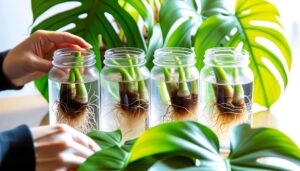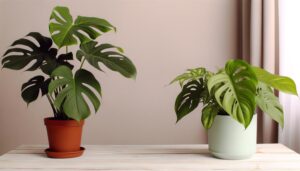How to Propagate Monstera Peru
To propagate Monstera Peru, start in spring or early summer for best growth. Use sterilized pruning shears to cut a healthy stem with at least one node and vibrant leaves.
Apply rooting hormone to the cut end and place it in water or moist sphagnum moss. Make sure the propagation medium is well-draining to prevent root rot.
Maintain a temperature between 65-75°F and provide bright, indirect light. Keep humidity levels at 60-70% using a humidifier or pebble tray.
Consistently monitor water levels and root development. For more details on achieving success in propagation, continue this guide.

Key Takeaways
- Choose a healthy stem with at least two nodes and vibrant leaves for cuttings.
- Sterilize pruning shears and make clean cuts below the nodes to avoid infection.
- Place the cuttings in water or moist sphagnum moss immediately after cutting.
- Keep the propagated cuttings in bright, indirect sunlight and maintain 60-70% humidity.
- Use a well-draining substrate and ensure the soil remains evenly moist to prevent root rot.
Choosing the Right Time
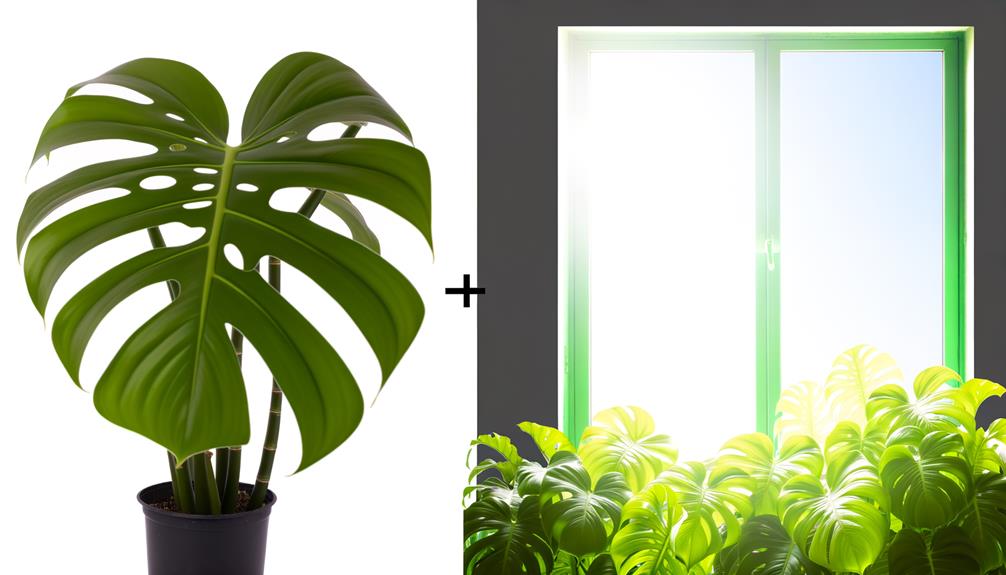
The best time for propagating Monstera Peru is during the spring or early summer when the plant's growth rate is at its peak. During this period, the plant's metabolic processes are highly active, increasing the likelihood of successful root development.
You'll want to monitor the ambient temperature, making sure it's consistently between 65-75°F (18-24°C). This temperature range optimizes enzymatic activities essential for cell division and root growth.
Additionally, consider the photoperiod; natural daylight should be around 12-14 hours, which you can supplement with grow lights if needed. Check that the mother plant is healthy and well-hydrated before initiating propagation. This preparation helps the cutting sustain itself during the initial stages of root formation, leading to more robust growth.
Gathering Necessary Supplies
You'll need to gather essential propagation tools such as sterilized pruning shears, rooting hormone, and a propagation medium like sphagnum moss or water.
Make sure you select healthy cuttings with at least one node and a few leaves, avoiding any with signs of disease or damage.
Proper preparation of these supplies will greatly enhance your success rate in propagating Monstera Peru.
Essential Propagation Tools
To successfully propagate Monstera Peru, start by gathering sharp trimming scissors, a sanitized cutting surface, rooting booster, a small container, well-draining substrate, and a transparent plastic bag. These tools create a hygienic setting and increase the chances of successful root establishment.
- Trimming scissors: Need to be sharp and disinfected for precise cuts.
- Cutting surface: Utilize a sanitized area to prevent contamination.
- Rooting booster: Accelerates root development, improving propagation success.
- Well-draining substrate: Aids in preventing water accumulation, supporting robust root growth.
When you've collected these items, you're prepared to establish ideal conditions for your plant cuttings. Each tool plays an essential role in the propagation process, ensuring you achieve the desired outcomes with scientific accuracy and attention.
Selecting Healthy Cuttings
Achieving successful propagation begins with selecting healthy cuttings, focusing on stems with at least two nodes and vibrant, unblemished leaves. Utilizing sterilized pruning shears, make a clean cut just below a node. Confirm the node is intact, as it's vital for root development.
Inspect leaves for signs of pests, disease, or discoloration; only choose those that exhibit strong, green pigmentation and no damage.
Once you've selected suitable cuttings, immediately place them in water or moist sphagnum moss to prevent dehydration. Gather your propagation supplies: a clean jar, distilled water, rooting hormone (optional), and a well-lit, warm environment.
Selecting a Healthy Cutting
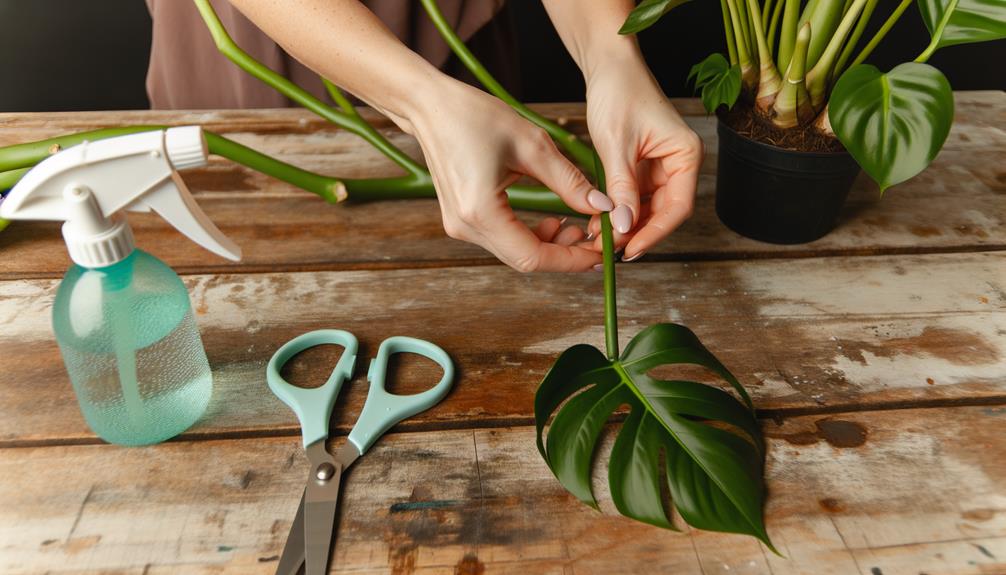
When selecting a healthy cutting for propagating Monstera Peru, make sure you identify mature nodes, which are essential for root development.
Inspect the plant carefully, and choose sections free from pests to prevent potential infestations.
Identify Mature Nodes
Locating a mature node on your Monstera Peru involves identifying the segment where the leaf and stem intersect, as this is where the plant's growth hormones are most concentrated. To guarantee successful propagation, you must select a cutting with a healthy, mature node. Here's what to look for:
- Node Visibility: The node should be clearly visible and not obscured by other plant parts.
- Aerial Roots: Look for small aerial roots emerging from the node, indicating active growth.
- Leaf Health: Verify the leaf at the node is vibrant and free from damage or discoloration.
- Stem Firmness: The stem around the node should be firm and not mushy, indicating it's free from disease.
Choose Pest-Free Sections
After identifying a mature node, select a cutting from a section free of any pests or signs of infestation to promote healthy propagation.
Inspect the stem and leaves thoroughly for any evidence of insects like aphids, mealybugs, or spider mites. Look for discoloration, spots, or deformities which can indicate disease. Use a magnifying glass if needed to ensure thorough examination. A pest-free cutting improves your chances of successful rooting and growth.
Once confirmed, sterilize your cutting tools with rubbing alcohol to prevent transferring any pathogens.
Preparing the Cutting
To prepare the cutting, identify a healthy Monstera Peru stem with at least one node and a few leaves. Using sterilized pruning shears, make a clean cut just below the node. The node is vital as it contains the latent buds necessary for root development. Ensure the cut section is 4-6 inches in length for best growth.
Follow these steps:
- Sterilize Your Tools: Clean your pruning shears with rubbing alcohol to prevent infection.
- Select a Node: Choose a stem that has at least one visible node and a few leaves.
- Make the Cut: Cut just below the node at a 45-degree angle for maximum surface area.
- Prepare the Cutting: Remove any leaves close to the node to promote root formation.
Water Propagation Method
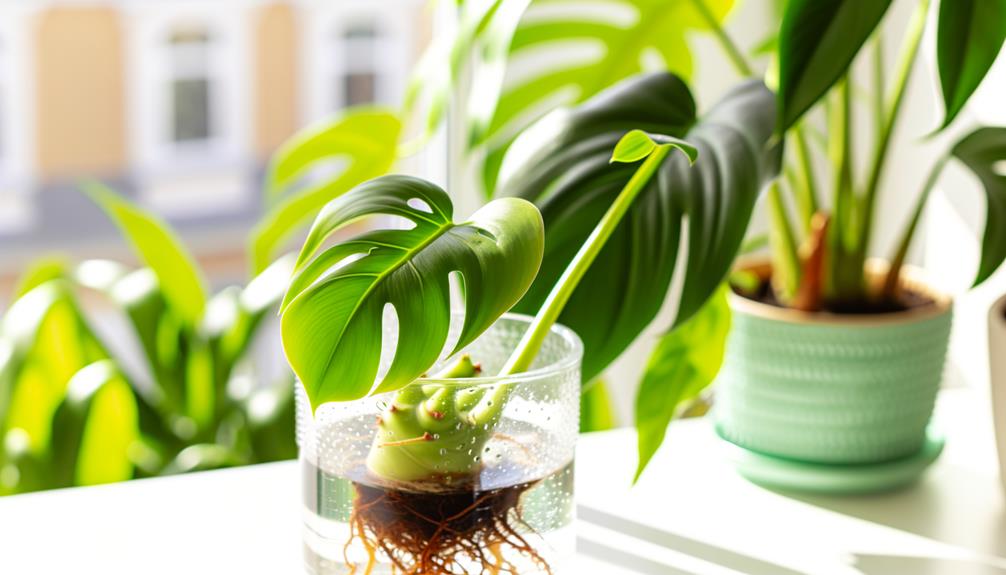
Now that you've prepared your cutting, place it in a clean container filled with water, making sure the node is submerged to promote root development.
Change the water every 3-5 days to prevent bacterial growth and provide oxygenation.
Position the container in indirect sunlight, as direct exposure can cause algae growth and damage the cutting.
Monitor the cutting daily for signs of root formation, typically emerging within 2-4 weeks.
Maintain a stable room temperature around 70-75°F (21-24°C) to optimize root growth.
Once roots are at least 2 inches long, they're robust enough for transplantation.
Avoid over-filling the container to guarantee sufficient air exchange.
This method allows you to visually track root progress, ensuring a healthy propagation process.
Soil Propagation Method
Start soil propagation by choosing a well-draining potting mix, like one designed for aroids, to guarantee ideal aeration and moisture retention. Make sure the pot has drainage holes to prevent waterlogging, which can lead to root rot.
Prepare the potting mix by moistening it slightly without making it soggy.
Follow these steps to maximize success:
- Select a healthy node – Ensure the cutting has a node, as it's essential for root development.
- Use rooting hormone – Dip the cut end in rooting hormone to stimulate root growth.
- Plant depth – Insert the cutting deep enough to cover the node.
- Maintain humidity – Cover with a plastic bag or use a humidity dome to create a humid microenvironment.
This method promotes robust root formation and plant stability.
Planting the Cutting
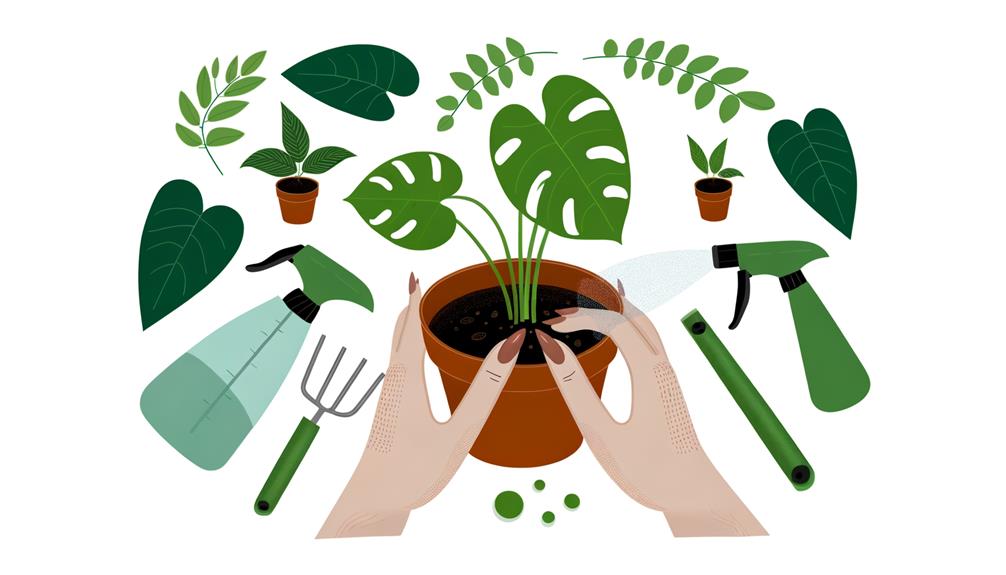
When planting the cutting, make sure the node is in firm contact with the potting mix to facilitate best root development. Use a sterile, well-draining potting mix rich in organic matter.
Create a small hole in the soil with your finger or a dibber, ensuring it's deep enough to cover the node entirely. Insert the cutting at an angle to maximize contact between the node and the soil. Gently press the soil around the cutting to eliminate air pockets, promoting better root establishment.
Water the cutting lightly to moisten the soil without causing waterlogging. Place the pot in a warm, humid environment to encourage root growth. Avoid direct sunlight, which can stress the cutting during this critical phase.
Providing Proper Care
Ensuring ideal growth for your Monstera Peru cutting requires maintaining consistent moisture levels in the soil, providing adequate light, and monitoring humidity. To promote the best possible development, follow these guidelines:
- Watering:
Keep the soil evenly moist but not saturated.
Use well-draining potting mix to prevent root rot.
- Light:
Place your cutting in bright, indirect sunlight.
Avoid direct sunlight as it can damage the leaves.
- Humidity:
Maintain a humidity level around 60-70%.
Use a humidifier or a pebble tray with water to increase ambient moisture.
- Temperature:
Keep the environment between 65-80°F (18-27°C).
Sudden temperature drops can stress the plant.
Monitoring Growth
Regularly monitoring your Monstera Peru's growth involves checking for new leaf development, root establishment, and overall plant health.
Inspect the cutting weekly for emergent leaves, which indicate successful photosynthetic activity and nutrient uptake.
Examine the roots by gently lifting the cutting; well-developed roots should be white or light brown and firm.
Assess overall plant health by observing leaf coloration and texture; healthy leaves are vibrant and free from spots or wilting.
Maintain prime conditions: temperature around 65-80°F (18-27°C), humidity above 60%, and indirect sunlight.
Address any issues promptly, such as yellowing leaves which might signify nutrient deficiencies.
Regularly mist the plant and optimize the soil remains moist but not waterlogged to support vigorous growth.
Conclusion
By following these steps meticulously, you'll master Monstera Peru propagation. Whether you choose water or soil methods, remember: patience is your ally.
Consistent attention fosters robust growth; monitor humidity levels and light exposure closely.
With diligence and accuracy, your cuttings will flourish into thriving plants.
Propagation isn't merely a task—it's a journey into the intricate dance of botany. Embrace it, and watch your Monstera Peru transform from a single cutting into a verdant marvel.

